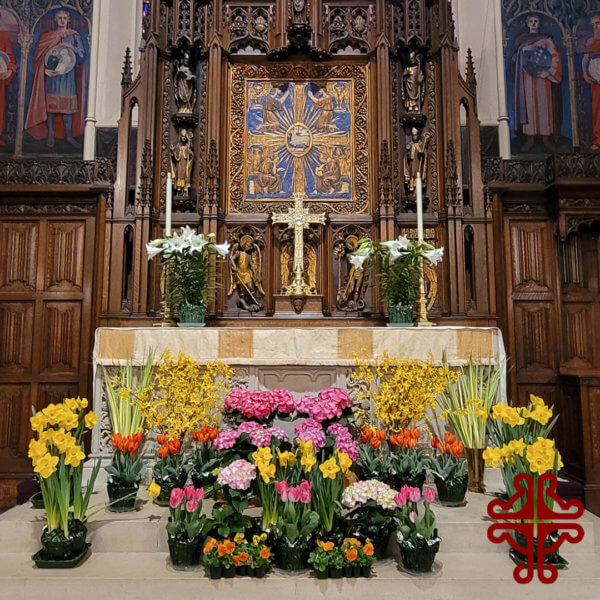
The Unsettling Power of Easter*
Alleluia! The Lord is risen! We started worship this morning celebrating Jesus’s resurrection. Now we’ve just heard the last words of Mark’s gospel, ending with Mother Mary, Mary Magdalene, and Salome, gripped by terror and amazement. They run away from the empty tomb because they were afraid, and say nothing to anyone.
 We’ve heard this story so many times before, we know the happy ending. Do we rush past the women’s terror and amazement, filling in details we imagine from Matthew, Luke, and John’s gospel? Glossing over the questions raised by Mark’s abrupt ending can separate us from discipleship, and even from Jesus. After all, the events of Holy Week happened far away in Jerusalem, to people who lived in a different time. From that safe, emotionally and historically distant perspective, we don’t feel the full weight of the disciples’ horror, grief, and upheaval during Holy Week, because it’s not about us. Let’s walk around in the disciples’ world for a while, imagining how what they experienced then would feel to us here and now, to get a better sense of Salome and the Marys’ state of mind.
We’ve heard this story so many times before, we know the happy ending. Do we rush past the women’s terror and amazement, filling in details we imagine from Matthew, Luke, and John’s gospel? Glossing over the questions raised by Mark’s abrupt ending can separate us from discipleship, and even from Jesus. After all, the events of Holy Week happened far away in Jerusalem, to people who lived in a different time. From that safe, emotionally and historically distant perspective, we don’t feel the full weight of the disciples’ horror, grief, and upheaval during Holy Week, because it’s not about us. Let’s walk around in the disciples’ world for a while, imagining how what they experienced then would feel to us here and now, to get a better sense of Salome and the Marys’ state of mind.
They watched — horrified and weeping — the torture and public execution of Jesus on Friday. The women — all good Jews — honored the Sabbath from sundown Friday through sundown Saturday, so they set out early Sunday to prepare Jesus’ body for the tomb. Preparing bodies for burial is tender, loving, motherly, and achingly sad work, even more difficult after witnessing the loved one’s brutal and intentional killing.
Jerusalem was under Roman occupation, and those in power were out in force to keep political order at the time of the Passover. Jesus had a lot of followers, and the political environment was volatile. We might imagine the rage, violence, and fear surrounding George Floyd’s or Breonna Taylor’s deaths this past year, or the incursion on the Capitol in January, or recent anti-Black and anti-Asian racism and violence to get our heads and hearts into Salome and the Marys’ experience. Mark’s gospel speaks directly into our own experience in pandemic time, letting us see ourselves in the action. Written in real time and spilling out fast like breaking news, there’s no time for flourishes or analysis. Mark begins with a breathless announcement — The Good News of Jesus Christ, the Son of God! He’s in such a hurry, he doesn’t even stop to put a verb in the first line.
And the gospel also ends abruptly, as we read this morning: the women get to Jesus’ tomb, find it empty, and run away, saying nothing to anyone, for they were afraid. Yes, that is the actual end of Mark’s gospel. And if you look back to the original Greek, the last word is not even afraid, as it is in the English translation. The last word is the Greek gar, which means for: the Marys and Salome fled without a word to anyone, they were afraid for… . Mark’s gospel ends, as it begins, with an incomplete sentence.
Stories are how human beings make sense of our environment, and we naturally seek closure. We crave a more satisfying ending that finishes all of the sentences and answers all the questions, taming the fear and confusion of the actual in-the-moment experience.That’s probably why some ancient versions of Mark’s gospel add three appearances by Jesus after the women are gripped with terror and amazement and run, although ancient scribes marked these additional verses as “doubtful.”
Mark’s gospel ends in mid-sentence, leaving us with the same confusion as the disciples must have felt after the roller coaster ride of Holy Week. The women went to the tomb to grieve and mourn Jesus’ death. They had rituals for loss, as we do now. But they found Jesus alive!
God’s Power is on the Loose
Wheaton College New Testament professor Esau McCaulley, wrote in a New York Times opinion piece last week that the women are seized by terror and amazement at the end of Mark’s gospel because they recognize that God’s power is on the loose and might very well unsettle the world. This idea gets lost among the Alleluias, but as Salome and the Marys show us, the only thing more terrifying than a world with Jesus dead is one in which he’s alive. They’d gone to the tomb that morning to bury Jesus. They had rituals for grief as we do now, but no detailed instructions on taking a leadership role in God’s grand plan of salvation! Maybe that’s where we stand in this Easter — in our post-vaccine pandemic resurrection. We know how to grieve, and we know how to complain — about our isolation, about COVID controls that restrict our freedom, and about what we can’t do. But partnering with the living God to reconcile with our neighbor, the stranger, our political systems, and those who don’t agree with us? I have to say that I find that holy opportunity terrifying and amazing!
After the bewildering end of Mark’s gospel, the next right step is back to the beginning to see what we missed the first time through. And there it is, in the very first words: The Good News of Jesus Christ, Son of God! No long soliloquies spoken in Holy Voice. No detailed instructions or tidy summaries. Just Jesus and the disciples back in the Galilee, doing God’s work, day by day. Simply terrifying. And amazing.
 This is the Good News of Jesus Christ, Son of God. Meet me in Galilee, Jesus says near the end of Mark’s gospel. Back in Chapter 1, we find Jesus there — curing the sick, casting out demons, feeding the hungry, welcoming the stranger. Retracing our steps back to the beginning in terror and amazement, we arrive, in T.S. Eliot’s words, where we started/And know the place for the first time. We can do this. Alleluia and Amen
This is the Good News of Jesus Christ, Son of God. Meet me in Galilee, Jesus says near the end of Mark’s gospel. Back in Chapter 1, we find Jesus there — curing the sick, casting out demons, feeding the hungry, welcoming the stranger. Retracing our steps back to the beginning in terror and amazement, we arrive, in T.S. Eliot’s words, where we started/And know the place for the first time. We can do this. Alleluia and Amen
* Esau McCaulley, “The Unsettling Power of Easter,” The New York Times, April 2, 2021.
